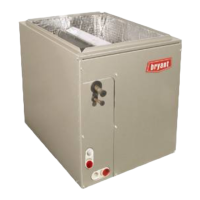CAPVP
Installation Instructions
Evaporator Coil
Upflow --- Downflow Cased
NOTE: Read the entire instruction manual before starting the
installation.
TABLE OF CONTENTS
PAGE
SAFETY CONSIDERATIONS 1.........................
INTRODUCTION 1...................................
INSTALLATION 2....................................
Inspect Equipment 2...............................
Select Installation 2................................
Installation of Evaporator Coils 2......................
Connect Refrigerant Piping 3.........................
Connect Lines 3...................................
Refrigerant Metering Device 4........................
Condensate Drain Line Connection 4...................
Waste Line Connection 4............................
SAFETY CONSIDERATIONS
Improper installation, adjustment, alteration, service, maintenance,
or use can cause explosion, fire, electrical shock or other conditions
which may cause death, personal injury or property damage.
Consult a qualified installer, service agency, or your distributor or
branch for information or assistance. The qualified installer or
agency must use factory--authorized kits or accessories when
modifying this product. Refer to the individual instructions
packaged with the kits or accessories when installing.
Follow all safety codes. Wear safety glasses, protective clothing
and work gloves. Use quenching cloths for brazing operations.
Have fire extinguisher available. Read these instructions
thoroughly and follow all warnings or cautions attached to the unit.
Consult local building codes and the current editions of the
National Electrical Codes (NEC) NFPA 70.
In Canada, refer to the current editions of the Canadian Electrical
Code CSA C22.1.
Recognize safety information. This is the safety-- alert symbol
.
When you see this symbol on the unit and in instructions or
manuals, be alert to the potential for personal injury.
Understand the signal words DANGER, WARNING and
CAUTION. These words are used with the safety--alert symbol.
DANGER identifies the most serious hazards which will result in
severe personal injury or death. WARNING signifies hazards
which could result in personal injury or death. CAUTION is used
to identify unsafe practices, which may result in minor personal
injury or product and property damage. NOTE is used to highlight
suggestions which will result in enhanced installation, reliability, or
operation.
ELECTRICAL SHOCK HAZARD
Failure to follow this warning could result in personal injury
or death.
Before installing or servicing system, always turn off main
power to system. There may be more than one disconnect
switch. Turn off accessory heater power if applicable. Lock out
and tag disconnect switch with a suitable warning label.
!
WARNING
EXPLOSION HAZARD
Failure to follow this warning could
result in death, serious personal injury,
and/or property damage.
Never use air or gases containing
oxygen for leak testing or operating
refrigerant compressors. Pressurized
mixtures of air or gases containing
oxygen can lead to an explosion.
!
WARNING
PERSONAL INJURY HAZARD
Failure to follow this caution may result in personal injury .
This coil contains Nitrogen precharge of up to 15 PSI. Release
of this pressure through the center of the rubber plugs is
required before removing the plugs.
CAUTION
!
CUT HAZARD
Failure to follow this caution may result in personal injury .
Sheet metal parts may have sharp edges or burrs. Use care and
wear appropriate protective clothing and gloves when
handling parts.
CAUTION
!
IMPORTANT: Nitrogen can leak out through the hole that the
needle pierced in the plugs. This does not indicate a leaking coil
nor warrant return of the coil.

